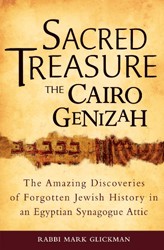Even Jews who joyously celebrate Passover each year might be hesitant to observe the holiday twice in one year. And yet, in 1117 CE, Rayyisa, the daughter of Saadya, married Yahya, the son of Abraham, in a mixed marriage. By that I mean one was a rabbinic Jew and one a Karaite. In their ketubah (marriage document) it was stipulated that they would not “profane each other’s holidays,” despite Karaites and rabbinic Jews in some years observing Passover a month apart due to their disparate calendars. This fascinating historical document taken from the Cairo Geniza is just one of the countless treasures depicted, and analyzed, in Jewish Treasures from Oxford Libraries, edited by Rebecca Abrams and Cesar Merchan-Hamann. Abrams, the Royal Literary Fund Fellow at Brasenose College, Oxford, and Merchan-Hamann, Hebrew and Judaica Curator in Oxford’s Bodleian library, have assembled a beautifully rendered showcase of the Bodleian’s Hebrew and Jewish manuscript and early printed book collection. Along with Cambridge University (which, as the book details, recently put aside its rivalry with Oxford as the two agreed to share a collection of Geniza fragments), Oxford houses a Judaica collection whose importance, as the book convincingly argues, “cannot be overstressed.”
Sir Thomas Bodley (1545−1613), a Protestant and passionate biblicist who himself composed letters and poems in Hebrew, restored what had been, in his time, a decrepit library, and ensured that Hebrew printed books and manuscripts were some of its earliest acquisitions. Following an introduction to both Bodley and the collection as a whole, Jewish Treasures’ chapters consist of contemporary scholars’ accessible surveys, complete with beautiful accompanying images, of the library’s major collections. Besides the aforementioned Geniza section, chapters cover the Laud, Pococke, Huntington, Kennicott, Canonici, Oppenheim, and Michael collections. The chapter on Oppenheim, written by Joshua Teplitsky, the author of the recent full-length treatment of its subject, The Prince of the Press, details how the Chief Rabbi of Prague, David Oppenheim (1664−1736), a lifelong bibliophile, ended up assembling a library that, “may be called, without exaggeration, the crown jewel of the Judaica holdings at Oxford University.” His 4,500 printed items and 1,000 manuscripts were a result of his mission to acquire a copy of every Jewish book in his day, from maps to Maimonides, wedding songs to Passover haggadahs, rabbinic commentaries on the Bible to women’s tkhines (Yiddish prayer books). Not all collectors were Jews, of course. Matteo Luigi Canonici (1727−1805) was a Jesuit priest and book and art dealer, whose contributions to the Bodleian include liturgical texts (Sephardi, Italian, and Western Ashkenazi), Talmudic tractates, Hebrew translations of Aristotle’s work, and illustrated kabbalistic texts.
As the editors demonstrate, Oxford’s collections of manuscripts and books from the Middle East, Europe, and North Africa, depict countless aspects of Jewish history, law, literature, and practice. From censored works demonstrating ideological and societal pressures, to annotations from readers whose names are lost to the sands of time, to wildly creative illuminations that demonstrate commonalities and differences with Christian and Muslim artists, these literary treasures continue to be mined by historians and laypeople alike for insights into the timeless treasure that is Judaism itself.
Dr. Stu Halpern is Senior Advisor to the Provost of Yeshiva University. He has edited or coedited 17 books, including Torah and Western Thought: Intellectual Portraits of Orthodoxy and Modernity and Books of the People: Revisiting Classic Works of Jewish Thought, and has lectured in synagogues, Hillels and adult Jewish educational settings across the U.S.





